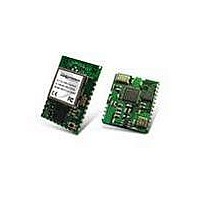WI.232EUR-R Radiotronix, WI.232EUR-R Datasheet - Page 7

WI.232EUR-R
Manufacturer Part Number
WI.232EUR-R
Description
EMBEDDED RADIO MODULE
Manufacturer
Radiotronix
Datasheet
1.RK-WI.232EUR-R.pdf
(29 pages)
Specifications of WI.232EUR-R
Frequency Rf
869.885MHz
Module Interface
Serial, UART
Tool / Board Applications
Wireless Connectivity-ZigBee, RF, Infrared, USB
Sensitivity
-106dBm
Data Rate Max
76.8Kbps
Supply Current
65mA
Maximum Frequency
869.885 MHz
Supply Voltage (max)
3.6 V
Supply Voltage (min)
2.7 V
Maximum Operating Temperature
+ 85 C
Minimum Frequency
868.225 MHz
Minimum Operating Temperature
- 40 C
Product
RF Modules
Frequency Range
868.225MHz To 869.885MHz
Supply Voltage Range
2.7V To 3.6V
Rohs Compliant
Yes
Lead Free Status / RoHS Status
Lead free / RoHS Compliant
Lead Free Status / RoHS Status
Lead free / RoHS Compliant
Figure 3: Wi.232EUR Networking Concept
The module is designed to interface directly to a host UART. Three signals are used to transfer
data between the module and the host UART: TXD, RXD, and CTS. TXD is the data output from
the module RXD is the data input to the module. CTS is an output that indicates the status of the
module’s data interface. If CTS is low, the module is ready to accept data. If CTS is high, the
module is busy and the host UART should not send any further data.
Internally, the module has a 192 byte buffer for incoming characters from the host UART. The
module can be programmed to automatically transmit when the buffer reaches a programmed
limit, set by regUARTMTU. The module can also be programmed to transmit based on
a delay between characters, set by regTXTO(set in 1mSec increments). These registers allow
the designer to optimize performance of the module for fixed length and variable length data. The
module will support streaming data, as well. To optimize the module for streaming data,
regUARTMTU should be set to 144, and regTXTO should be set to a value equal to 1 byte time
at the current UART data rate or 2, whichever is greater. If the buffer is full, or the timer set by
regTXTO expires, and the module is in the process of sending the previous packet over the RF
link, the module will assert CTS high, indicating that the host should not send any more data.
Data sent by the host while CTS is high will be lost.
When the MAC layer has a packet to send, it will use a carrier-sense-multiple-access (CSMA)
protocol to determine if another module is already transmitting. If another module is transmitting,
the module will receive that data before attempting to transmit its data again. If, during this
process, the UART receive buffer gets full, the CTS line will go high to prevent the host UART
from over-running the receive buffer. The CSMA mechanism introduces a variable delay to the
transmission channel. This delay is the sum of a random period and a weighted period that is
dependent on the number of times that the module has tried and failed to acquire the channel.
For applications that guarantee that only one module will be transmitting at any given time, the
CSMA mechanism can be turned off to avoid this delay.
The MAC layer prefixes the data with a packet header and postfixes the data with a 16-bit CRC.
The 16-bit CRC error checking can be disabled to allow the application to do its own error
checking. Data is encoded using a proprietary algorithm (DirectSPREAD™) to spread the RF
energy equally within the transmission bandwidth.
Wi.232EUR User’s Manual
© 2003-2007 Radiotronix Inc.
6














